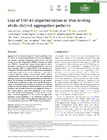Loss of TDP-43 oligomerization or RNA binding elicits distinct aggregation patterns
Abstract
Aggregation of the RNA-binding protein TAR DNA-binding protein 43 (TDP-43) is the key neuropathological feature of neurodegenerative diseases, including amyotrophic lateral sclerosis (ALS) and frontotemporal lobar degeneration (FTLD). In physiological conditions, TDP-43 is predominantly nuclear, forms oligomers, and is contained in biomolecular condensates assembled by liquid-liquid phase separation (LLPS). In disease, TDP-43 forms cytoplasmic or intranuclear inclusions. How TDP-43 transitions from physiological to pathological states remains poorly understood. Using a variety of cellular systems to express structure-based TDP-43 variants, including human neurons and cell lines with near-physiological expression levels, we show that oligomerization and RNA binding govern TDP-43 stability, splicing functionality, LLPS, and subcellular localization. Importantly, our data reveal that TDP-43 oligomerization is modulated by RNA binding. By mimicking the impaired proteasomal activity observed in ALS/FTLD patients, we found that monomeric TDP-43 forms inclusions in the cytoplasm, whereas its RNA binding-deficient counterpart aggregated in the nucleus. These differentially localized aggregates emerged via distinct pathways: LLPS-driven aggregation in the nucleus and aggresome-dependent inclusion formation in the cytoplasm. Therefore, our work unravels the origins of heterogeneous pathological species reminiscent of those occurring in TDP-43 proteinopathy patients. Show more
Permanent link
https://doi.org/10.3929/ethz-b-000623487Publication status
publishedExternal links
Journal / series
The EMBO JournalVolume
Pages / Article No.
Publisher
EMBO PressSubject
aggregation; LLPS; oligomerization; RNA; TDP-43Organisational unit
03591 - Allain, Frédéric / Allain, Frédéric
Funding
182880 - NCCR RNA&Disease (51NF40-182880): Flexibility Grant (SNF)
More
Show all metadata





